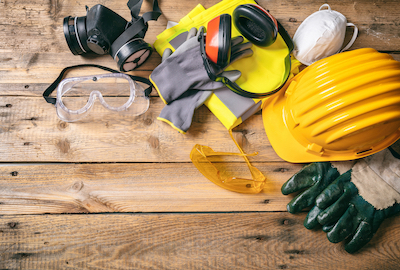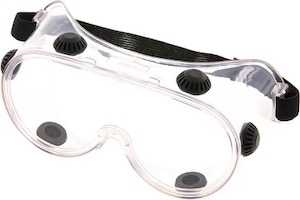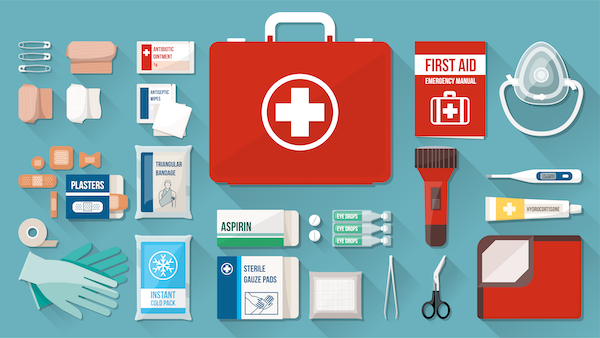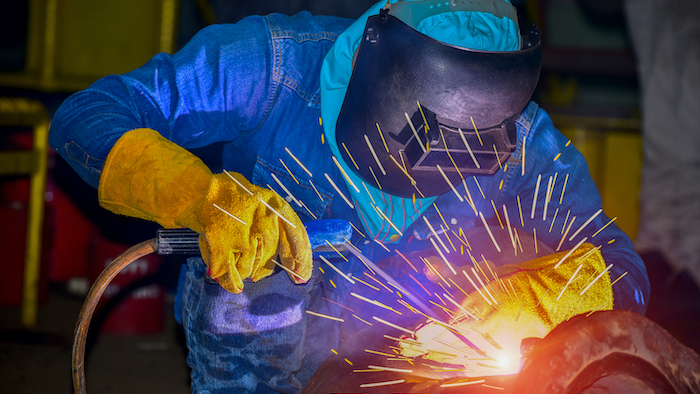Industrial PPE Equipment Overview

Figure 1: A collection of PPE equipment
Personal Protective Equipment (PPE) are tools and accessories worn to guarantee users' safety and health protection. Typically, PPE is worn when there's a risk of exposure to health and safety hazards. Workers wear industrial PPE to protect themselves from physical, mechanical, electrical, and other workplace hazards in an industrial setting.
Industrial PPE consists of any clothing or work accessories designed to protect against workplace hazards. Nonetheless, wearing the accessories does not eliminate the risks, and if the accessories fail, exposure will undoubtedly occur. That said, here's an overview of industrial personal protection equipment.
Table of contents
View our online selection of safety goggles and safety hoods!
Types of PPE
The Occupational Safety and Health Administration (OSHA) mandates employers to assess their workplaces and determine whether the hazards require eye, face, hand, foot, or head protection.
Head PPE equipment
Head equipment protects against impact blows to the head. Helmets come in different classes and don't offer the same level of protection. So, finding a helmet type suited to the work environment is highly important. The American National Standards Institute (ANSI) categorizes helmets into different types and categories:
- Type 1: These are helmets with a full brim more than 1¼ inches wide around the entire hat
- Type 2: These helmets come with a short brim that extends forward from the crown
There are three electrical performance classes:
- Class A: protects the head against low-voltage electrical conductors, impact, and penetration. Helmets get proof-tested at 2,200V of electric charge for certification purposes.
- Class B: These are utility service helmets, and they protect against penetration, impact, and high-voltage electrical conductors. Proof-testing for class B occurs at 20,000V.
- Class C: Class C helmets are typically made from aluminum and only offer penetration and impact protection. Thus, they should not be used in areas with electrical hazards.
The voltages indicated in Classes A and B don't state the voltage the helmets protect wearers. Helmets also get tested for penetration and impact resistance from flames, water absorption, and blows to the top of wearers' heads.

Figure 2: Safety helmets and ear protection are important PPE for a safe working environment.
Leg and foot protection
In any workplace, there's a high risk of foot injuries. These injuries primarily occur while employees perform their normal activities at the workplace. Leg and foot PPE protects against rolling or falling objects, molten metal, hot water and steam, wet slippery surfaces, and sharp objects. Steel-toed boots are the most common leg and foot PPE in industrial plants. Similar protective equipment includes leggings and footguards.
Overalls are a must-have in industrial plants, and they protect workers and other occupants from chemical hazards, flames, liquid spills, and other hazards. When working in tight spaces, overalls protect workers from bruises and similar injuries while ensuring comfort. Furthermore, most overalls come with pockets designed to help workers carry their tools safely and comfortably.
Face and eye protection
Employers should provide suitable eye protectors at workplaces with the potential for injury to the face or eyes from liquid chemicals, acids, molten metal, flying particles, vapors, and other hazardous materials. Eye and face PPE equipment should meet the following requirements:
- Provide adequate protection to the eyes and face
- Be comfortable when who under their designated conditions
- Fit without interfering with the wearer's movements and vision
- Easy to clean and repair
Standard eye and face PPEs include safety glasses, chemical safety goggles, impact goggles, welding helmets, full-face respirators, and face shields.

Figure 3: A pair of safety goggles
Ear protection
Continued exposure to high noise levels can cause hearing impairments and loss. Unfortunately, noise-induced hearing loss has no cure. Avoiding exposure is the only way to prevent hearing damage. In industrial settings, specifically designed ear protection PPE is required. Disposable earplugs are the most common ear protection PPE while earmuffs ensure a perfect seal around the ears.
Hand and arm protection
Hand and arm injuries commonly result from electric shock, burns, amputation, cuts, and chemical absorption. Most PPE offer protection from these hazards, including hand pads, sleeves, wristlets, and safety gloves.
PPE equipment should be selected according to the intended purpose. Likewise, each material should get thoroughly tested and rated against different chemical compounds. Thus, buyers should know what hazard they're protecting against to choose the most suitable PPE material. Rubber is the ideal material for hand gloves and sleeves due to its high-strength construction and insulating properties.
Respiratory protection
In industrial settings, it's easy to breathe air contaminated with toxic fumes, smoke, sprays, vapors, gases, and dust. Even with the use of emergency controls to eliminate these dangerous substances from the air, respiratory protection PPEs can help avoid inhalation hazards.
Respiratory protection PPEs can either be air-purifying or atmosphere-supplying, and each of them provides a different protection level based on design. Thus, it's best to choose the appropriate respiratory protection PPE for the specific respiratory hazard.
Typical respiratory protectors include face masks, filtering facepiece respirators (FFRs), elastomeric full facial respirators, powered air-purifying respirators, and half-masks.
First aid kits
Scrapes, burns, cuts, and similar injuries are commonplace in industrial plants. Although a first aid kit isn't a PPE, having one close by can help you manage different types of damages. First aid kits are available for specific applications and work environments, such as electrical, construction, metalworking, or woodworking. Immediate treatment lowers the risk of minor injuries becoming severe. Hence, it's advisable to have a couple of well-stocked first aid kits at your workplace.

Figure 5: First aid kits can be designed for different applications, choose the correct one for yours.
Spill kits
Industrial environments with hazardous materials should have spill kits on hand. Common spill kits include oil mats and pads, oil sheets, and oil socks.
Industrial PPE selection criteria
When buying personal protective equipment, one question runs on many people's minds: How do I choose the correct PPE? Well, here are the PPE selection criteria to keep in mind:
Be familiar with potential hazards
PPE buyers should familiarize themselves with potential hazards in their workplace, enabling them to determine the most appropriate PPE to use. Educating oneself about potential dangers entails anticipating the type and extent of exposure.
Consider the hazards' link to the environment
Select industrial PPE that provides superior protection rather than meeting the minimum requirements. Workers must undergo proper training. As well, they should know the limitations of the equipment.
PPE procedure and policies
Another vital selection criteria for PPEs is their policies and procedures. It's good practice to choose PPE with clear policies and procedures regarding selection, training fit testing, and use and maintenance.

Figure 6: Analyze the dangers in an application carefully to determine the correct PPE
FAQs
What regulations apply to PPE?
The ANSI outlines industry-specific guidelines on standards, specifications, and test methods for PPE. Thus, select PPE based on the potential hazards and the risk of exposure.
Is training needed to use PPE?
Where PPE gets provided, train employees on using them and the hazards in play, and this makes it easier for them to use the PPE correctly and effectively.
Do employees have to wear PPE?
To prevent workplace accidents and injuries, wear PPE correctly at all times. Report defects immediately to fix or replace the safety equipment.
How should PPE be stored?
Store all industrial PPE according to the manufacturer's instructions. Poor storage comes with the risk of deterioration due to dirt, oil, and UV exposure.









